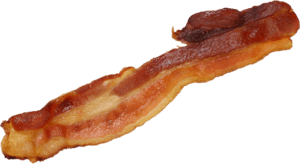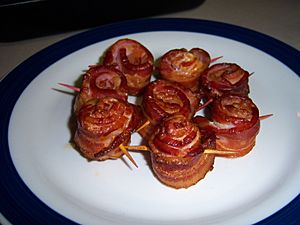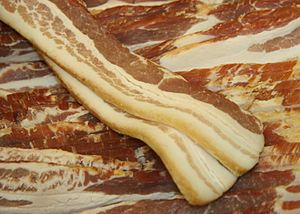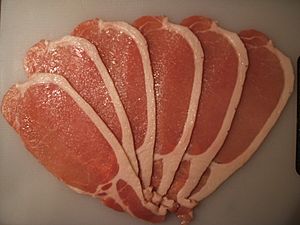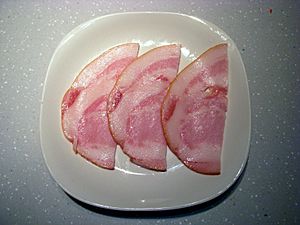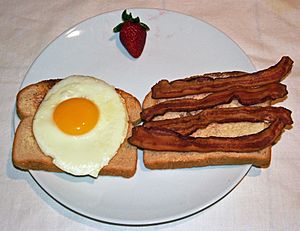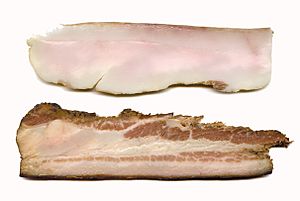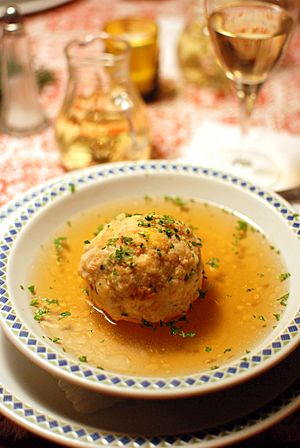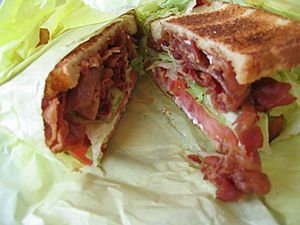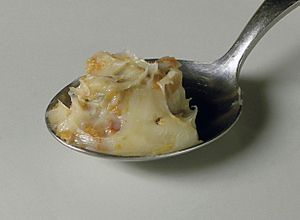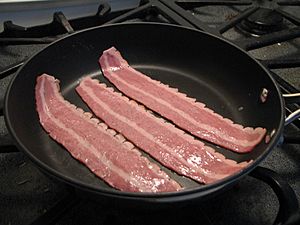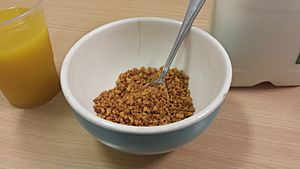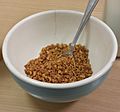Bacon facts for kids
Bacon is a popular meat that comes from pork. It is made by a special process called curing. This means the pork is treated with a lot of salt. Sometimes it's soaked in salty water (called a brine), or it's covered in dry salt.
After curing, bacon can be dried for a long time in cool air. It can also be boiled or smoked. Most fresh or dried bacon needs to be cooked before you eat it. People often cook it by frying it in a pan. Some boiled or smoked bacon is already ready to eat. However, you can cook it more if you want.
Bacon can be made from different parts of the pig. It often comes from the pork belly. It can also come from back cuts, which have less fat.
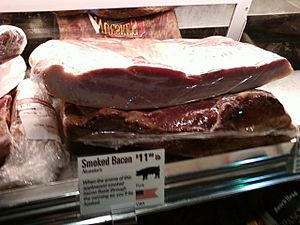
You can eat bacon in many ways: smoked, boiled, fried, baked, or grilled. It's often eaten by itself or as a side dish, especially with breakfast. Bacon is also used to add flavor to other foods. For example, it's a key part of a club sandwich. Sometimes, bacon is wrapped around roasts, like venison (deer meat) or pheasant, to keep them moist and add flavor.
The word "bacon" comes from an old German word, bacho. This word meant "buttock," "ham," or "side of bacon."
Sometimes, meat from other animals is made to look and taste like bacon. This can include beef, lamb, chicken, goat, or turkey. These types of "bacon" are common in places where people follow Jewish or Muslim rules. These rules do not allow eating pork.
For safety, bacon is treated to prevent a tiny worm called Trichinella. This worm can be destroyed by heating, freezing, drying, or smoking the meat.
Contents
How is Bacon Made?
Bacon is made by curing it. This means the pork is either injected with a salty liquid or soaked in it. Another way is to rub it with plain salt, which is called dry curing.
In America, bacon is usually cured and then smoked. Different types of wood, like hickory, can be used to give it different flavors. Sometimes, even corn cobs are used! In the United Kingdom, peat (a type of soil) is sometimes used for smoking. This smoking process can take many hours. The longer it smokes, the stronger the flavor.
In the United Kingdom and Ireland, you can find both smoked and unsmoked bacon. Unsmoked bacon is often called "green bacon."
Bacon is different from salt pork and ham. The main difference is in the special ingredients added to the salt mixture. Bacon brine often has sodium nitrite. This helps with curing and keeps the color stable. Sometimes, sweet flavors like brown sugar or maple syrup are added to some bacon products.
Different Kinds of Bacon
Bacon comes from different parts of the pig. This is why there are different kinds:
- Side Bacon or Streaky Bacon comes from the pork belly. It has a lot of fat in long layers. This is the most common type of bacon in the United States. "Slab bacon" is side bacon that has not been sliced yet.
- Pancetta is an Italian streaky bacon. It can be smoked or unsmoked. It has a strong flavor and is often rolled into a cylinder after curing.
- Back Bacon comes from the middle of the pig's back. This cut is very lean and meaty. It has less fat than streaky bacon. Most bacon eaten in the United Kingdom and Ireland is back bacon.
- Collar Bacon is taken from the back of the pig, closer to its head.
- Cottage Bacon is a thin slice of lean pork from the shoulder. It's usually oval-shaped and meaty. It's cured and then sliced into round pieces for cooking.
- Jowl Bacon is made from the cured and smoked cheeks of a pig. Guanciale is an Italian jowl bacon that is seasoned and dry cured but not smoked.
The type of bacon used depends on what people like in different places. In the United States, when people say "bacon," they usually mean belly bacon. Back cuts are called "Canadian bacon."
Bacon Around the World
Bacon is often served with eggs and sausages as part of a big breakfast. The skin left on the bacon is called 'bacon rind'. However, many people prefer bacon without the rind. You can buy bacon that is already smoked or unsmoked.
Australia and New Zealand
In Australia and New Zealand, the most common type is 'middle bacon'. This includes some of the streaky, fatty part and also a lean part from the back. Some supermarkets also sell 'short cut bacon'. This is just the lean part and usually costs a bit more. Both types are often sold without the rind.
Canada
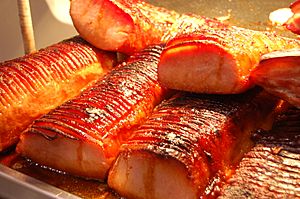
In Canada, 'bacon' usually means side bacon. 'Back bacon' is cut from the boneless pork loin. In the United States, this is called 'Canadian bacon' when it's cut into a thick, round shape.
Peameal bacon is a special type of back bacon. It's cured and then covered in fine cornmeal. (A long time ago, it was rolled in ground dried peas!) Bacon is a very popular breakfast food in Canada.
Germany
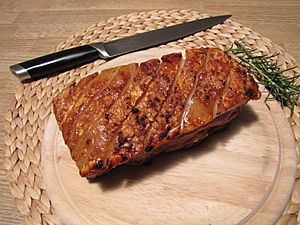
In Germany, the word Speck is similar to bacon. Germans use the word bacon especially for Frühstücksspeck, which means 'breakfast Speck'. This is cured or smoked pork slices. Traditional German cold cuts often use ham more than bacon. However, "Wammerl" (grilled pork belly) is still popular in Bavaria.
Small bacon cubes, called "Grieben" or "Grammerln" in Austria and southern Germany, are important in many dishes. They add flavor to soups and salads. They are also used in dumplings and potato dishes. You can even buy them ready-made in stores now.
Japan
In Japan, bacon is called "bēkon" (ベーコン). It's cured and smoked belly meat, just like in the US. It's sold in regular or half-length sizes. Japanese bacon is often pre-cooked and has a texture similar to ham when cooked. Uncured belly slices, called bara (バラ), are also very popular. They are used in many dishes like yakitori and yakiniku.
United Kingdom and Ireland
A thin slice of bacon is called a 'rasher'. Bacon is usually called either streaky or back bacon.
- When people just say 'bacon', they usually mean back bacon.
- Bacon from the pork belly, with layers of meat and fat, is called 'streaky bacon'.
- Bacon from the back of the pig is 'back bacon'. It usually has a streaky part and a lean, oval part.
Bacon can be cured in different ways. It can be smoked or unsmoked. Many curing methods add water to the meat. Bacon sold as "dry cured" does not have added water. For example, you might see "dry-cured unsmoked back bacon" in a shop.
Fried or grilled bacon rashers are a key part of the traditional full breakfast. This breakfast is a bit different in each country, like the "full Scottish" breakfast.
United States
A whole piece of unsliced bacon is called a 'slab'. A single piece of bacon is a 'slice' or 'strip'.
American bacon can be smoked with different woods, like hickory, mesquite, or applewood. It can also have flavors like chili pepper, maple, brown sugar, honey, or molasses.
- The word "bacon" usually means strip bacon from the pig's belly. This is the most popular type in the US.
- "Canadian bacon" is made from the pork loin. It's usually sold in thick, pre-cooked slices.
Bacon Dishes
Many dishes use bacon. Some popular ones include bacon and eggs, bacon, lettuce, and tomato (BLT) sandwiches, Cobb salad, and foods wrapped in bacon. You might see scallops, shrimp, or asparagus wrapped in bacon.
Some newer bacon dishes include chicken fried bacon and chocolate covered bacon. Tatws Pum Munud is a traditional Welsh stew with potatoes, vegetables, and smoked bacon. You can also find Bacon jam and bacon marmalade in stores.
In the US and Europe, bacon is often used as a condiment or topping. This is often in the form of bacon bits. Streaky bacon is commonly used as a topping on foods like pizza, salads, sandwiches, hamburgers, baked potatoes, hot dogs, and soups.
Bacon is also used in different versions of dishes. For example, you can have bacon-wrapped meatloaf. It can also be mixed with green beans or served over spinach.
Bacon Fat
When bacon is heated, its fat melts and becomes bacon dripping. Once it cools, it turns into a solid fat. This fat is very flavorful and is used for cooking. In British and southern US cuisine, bacon grease is often saved. It's used as a base for cooking and to add flavor to many dishes. This includes gravy, cornbread, and even salad dressing.
In Germany, if streaky pork belly bacon is cut into cubes and used to make lard, some parts that don't melt completely are roasted and stay in the lard. This creates Griebenschmalz, a popular spread.
Bacon, or bacon fat, is often used to wrap around roasted birds or game animals. This is especially true for those that don't have much fat themselves. This wrapping helps keep the meat moist. For example, filet mignon beef is often wrapped in bacon before cooking. The bacon can be eaten afterward or discarded.
One small spoon (about 4 grams) of bacon grease has about 38 calories. It's mostly fat and doesn't have much other nutrition. About 40% of bacon fat is saturated.
Health Information
Bacon has a lot of sodium (salt). Eating too much sodium can be linked to heart disease and high blood pressure.
Many doctors believe that eating too much bacon can be unhealthy.
In 2010, researchers from the Harvard School of Public Health found something important. They discovered that eating processed meats like bacon (which are preserved by smoking, curing, or salting) was linked to a higher risk of both heart disease and diabetes.
Other Kinds of Bacon
Many different types of bacon alternatives have been made. These are for people who cannot or prefer not to eat regular pork bacon.
Turkey Bacon
Turkey bacon is a popular choice instead of pork bacon. People might choose it for health reasons, religious rules, or other reasons. It has less fat and fewer calories than pork bacon. You can use it in similar ways, like in a BLT sandwich.
Turkey bacon is made from the whole turkey. It can be cured or uncured, smoked, chopped, and then shaped into strips that look like bacon. You cook turkey bacon by frying it in a pan. Cured turkey bacon made from dark meat can be 90% fat free. Because it has less fat, turkey bacon doesn't shrink as much when cooked. It also tends to stick to the pan more easily.
Macon
Macon is another alternative to bacon. It's made by curing cuts of mutton (lamb meat) in a similar way to pork bacon. It was first made in Scotland. It became popular in Britain during World War II because of food rationing. Today, it's available as an alternative to bacon, especially for the Muslim market. It looks a lot like pork bacon, but its color is usually black and yellow.
Vegetarian Bacon
Vegetarian bacon, also called fakon, veggie bacon, or vacon, is a product sold in supermarkets. It's made for people who don't eat meat. It has no cholesterol, is low in fat, and has a lot of protein and fiber. Two slices have about 74 calories. Vegetarian bacon is usually made from marinated strips of tofu or tempeh.
Bacon-Flavored Products
Bacon is very popular in the United States. This has led to many products that taste like bacon. These products let you enjoy the bacon flavor without cooking it or worrying about some of bacon's qualities.
Bacon Bits
Bacon bits are often used as a topping on salads or potatoes. They are a common item at salad bars. They are usually salty. Bacon bits are made from small, crumbled pieces of bacon. In factories, they are cooked in special microwave ovens. Similar products are made from ham or turkey. There are also fake bacon bits made from textured vegetable protein that are flavored to taste like bacon.
Other Bacon-Flavored Products
There are many other products that taste like bacon. These include bacon-flavored salt (Bacon Salt), Baconnaise (a mayonnaise that tastes like bacon), Bacon Grill (a canned meat similar to Spam), and even bacon ice cream.
Images for kids
-
A bacon, lettuce, and tomato (BLT) sandwich
See also
 In Spanish: Panceta para niños
In Spanish: Panceta para niños


